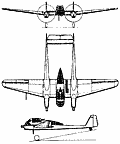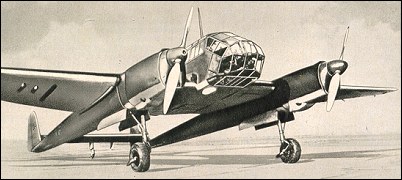|
| The Uhu was first flown in July 1938 and entered service with the Luftwaffe from 1940 as a short-range reconnaissance and army co-operation aircraft. Armament comprised four 7.9mm machine-guns and two or four 50kg bombs. The central crew nacelle, projecting rearwards between the twin tailbooms, was extensively glazed and provided excellent all-round vision for the crew of three. Operated mainly on the Eastern Front, the Uhu remained in production until 1944, by which time nearly 850 aircraft had been completed, including a number of purpose-built five-seat trainers. However, because of the low speed of the aircraft, its use was subsequently restricted to less active duties, such as evacuation of wounded, radio training and communications.

| MODEL | Fw 189A-1 |
| CREW | 2-3 |
| ENGINE | 2 x Argus As 410A-1, 347kW |
| WEIGHTS |
| Take-off weight | 3950 kg | 8708 lb |
| Empty weight | 2805 kg | 6184 lb |
| DIMENSIONS |
| Wingspan | 18.4 m | 60 ft 4 in |
| Length | 12.03 m | 39 ft 6 in |
| Height | 3.1 m | 10 ft 2 in |
| Wing area | 38.0 m2 | 409.03 sq ft |
| PERFORMANCE |
| Max. speed | 335 km/h | 208 mph |
| Cruise speed | 315 km/h | 196 mph |
| Ceiling | 7000 m | 22950 ft |
| Range | 670 km | 416 miles |
| ARMAMENT | 4 x 7.92mm machine-guns, 4 x 50kg bombs |
 | A three-view drawing (1000 x 778) |
| sven, 06.08.2016 13:29 re; my previouse comment . Anyone care to speculate on which Focke Wulf twin might have been used to carry 2 crew and a passenger to a parachute drop? reply | | Barry, 25.01.2013 19:07 There were 864 Fw 189's built including prototypes. Not only were they built by Focke-Wulf but also Heinkel with others being manufactured by Aero in Prague between 1940 and 1943, and by SNCASO at Bordeaux-Merignac untill 1944. They were supplied to the Hungarian and Slovakian air forces operating on the Eastern Front. The colour illustration shows an Fw189-1 Uhu of 1.(H) /32 based at Kemi Finland in June 1942. reply | | balls, 15.08.2012 23:02 i want to suck your dick reply | | Sven, 06.02.2012 13:13 Is this the aircraft that took agent Zig Zag to his drop point in Cambridgeshire? I spoke to Eddie about the aircraft and he was certain that it was a twin engined high performance special recon aircraft.
However I suspect that his german handlers were not without a sense of humour.
They had little choice of aircraft and bolsterd Eddies confidence with the tale of a special aeroplane. No other twin engined aircraft from FW fits the bill.
Informed comment most welcome. reply | |
| | bill, 05.02.2012 21:45 i want to suck all your dicks reply | | Pyropuncher, 31.12.2011 04:59 With my Knowledge of aircraft i am very good at naming Powerplants and other i am a expert on this stuff Yes i am the real Pyropuncher i am going to lancaster university U.K. reply | | guba, e-mail, 20.06.2011 11:59 The oil pressure adjusts propeller pitch, if the load on the propeller increases ie during climpb, the pressure falls and the pitch is decreased (fine pitch). Hope this helps reply | | elroto, e-mail, 31.10.2008 20:37 I believe that there is a conserted effort to restore an owl back to airworthy condition somewhere in Russia. reply | | Richard Stankiewicz, e-mail, 13.11.2007 22:15 The vanes are part of the constant speed feature of the propeller. The fins are attached to the spinner and is free to spin,the spinner is attached to a small oil pump.
The oil pressure adjusts propeller pitch, if the load on the propeller increases ie during climpb, the pressure falls and the pitch is decreased (fine pitch). Hope this helps reply | | Kenneth Mitchell, e-mail, 11.09.2007 23:38 What was the purpose of the strange looking spinners on the props? Was there a purpose for the little vanes on the front of them? Thanks for your time in this matter.
ken reply | | Gerry Jarvis, e-mail, 17.12.2006 05:06 Question for anyone with either very specialized knowledge or a good educated guess... Of what aerodynamic benefit are the triangular vanes affixed to the Uhu's prop spinners? Are they maybe part of a constant-speed or pitch-change mechanism? Seems they'd disturb airflow right at a bad place for disturbed airflow. Anyone have any ideas? reply |
|
Do you have any comments?
|
| 
COMPANY
PROFILE
All the World's Rotorcraft
|








